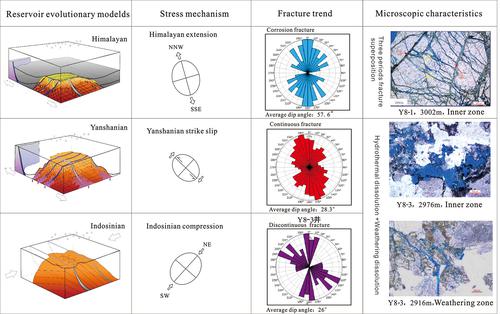当前位置:
X-MOL 学术
›
Acta Geol. Sinica Engl. Ed.
›
论文详情
Our official English website, www.x-mol.net, welcomes your
feedback! (Note: you will need to create a separate account there.)
Reservoir Characteristics and Genetic Mechanisms of the Mesozoic Granite Buried Hills in the Deep‐water of the Qiongdongnan Basin, Northern South China Sea
Acta Geologica Sinica-English Edition ( IF 3.5 ) Pub Date : 2021-01-08 , DOI: 10.1111/1755-6724.14635 Li YOU 1 , Shouli XU 1 , Xuelian MAO 1 , Jia ZHONG 1 , Yaoqi JIAO 1 , Xiaofeng XIONG 1
Acta Geologica Sinica-English Edition ( IF 3.5 ) Pub Date : 2021-01-08 , DOI: 10.1111/1755-6724.14635 Li YOU 1 , Shouli XU 1 , Xuelian MAO 1 , Jia ZHONG 1 , Yaoqi JIAO 1 , Xiaofeng XIONG 1
Affiliation

|
Due to its structure, rock and mineral composition, fluid and other factors, the granite Buried Hill Reservoir is highly heterogeneous with a complex longitudinal structure and a reservoir space made up of a combination of dissolution pores and fractures. This paper is based on current understanding of tectonic evolution in the northern part of the South China Sea, in conjunction with the seismic phase characteristics. It is determined that the meshed fault system was formed by three stages of movement ‐ tectonic compression orogeny during the Indochinese epoch, strike‐slip compression‐tension during the Yanshanian Period, early fracture extension activation during the Himalayan – which controlled the distribution of the Buried Hill Reservoir. Drilling revealed two types of buried hills, faulted anticline and fault horst, their longitudinal structure and the reservoir space type being significantly different. The mineral composition, reservoir space and diagenetic characteristics of the reservoir rocks and minerals were analyzed by lithogeochemistry, microsection and logging etc., it thus being determined that the Mesozoic rocks of the Songnan Low Uplift in the Qiongdongnan Basin are mainly composed of syenogranite, granodiorite, monzogranite, which is the material basis for the development of the Buried Hill Reservoir. The content of felsic and other brittle minerals is more than 70%, making it easy for it to be transformed into fractures. At the same time, the weathering resistance of granodiorite and monzogranite is weaker than that of syenogranite, which is easily weathered and destroyed, forming a thick sand gravel weathering zone. With increasing depth of burial, weathering and dissolution gradually weaken, the deep acidic fluid improving the reservoir property of internal fractures and expanding the vertical distribution range of the reservoirs. The research results lay a foundation for the exploration of Buried Hill in the deep‐water area of the Qiongdongnan Basin.
中文翻译:

南海北部琼东南盆地深水区中生代花岗岩埋山储层特征及成因机理
由于其结构,岩石和矿物组成,流体和其他因素,花岗岩埋山储层高度非均质,具有复杂的纵向结构以及由溶蚀孔隙和裂缝共同构成的储层空间。本文基于当前对南海北部构造演化的认识以及地震相特征。已确定网状断层系统是由印度支那时期的运动构造压缩造山运动的三个阶段,燕山时期的走滑滑动压缩张力,喜马拉雅时期的早期裂缝延伸活化控制的,这三个阶段控制了埋藏的分布。小山水库。钻探揭示了两种类型的潜山,断层背斜和断层地壳,它们的纵向结构和储层空间类型明显不同。通过岩性,显微切片和测井等方法对储集岩和矿物的矿物组成,储集空间和成岩特征进行了分析,从而确定琼东南盆地松南低隆起的中生代岩石主要由正长花岗岩,花岗闪长岩组成。 ,辉长花岗岩,是埋藏山水库开发的物质基础。长英质和其他脆性矿物的含量超过70%,因此很容易转变成裂缝。同时,花岗闪长岩和辉长岩的耐候性比正花岗岩强,较易风化和破坏,形成了较厚的砂砾风化带。随着埋藏深度的增加,风化作用和溶蚀作用逐渐减弱,深酸性流体改善了内部裂缝的储层性质,扩大了储层的垂向分布范围。研究成果为琼东南盆地深水区潜山的勘探奠定了基础。
更新日期:2021-02-22
中文翻译:

南海北部琼东南盆地深水区中生代花岗岩埋山储层特征及成因机理
由于其结构,岩石和矿物组成,流体和其他因素,花岗岩埋山储层高度非均质,具有复杂的纵向结构以及由溶蚀孔隙和裂缝共同构成的储层空间。本文基于当前对南海北部构造演化的认识以及地震相特征。已确定网状断层系统是由印度支那时期的运动构造压缩造山运动的三个阶段,燕山时期的走滑滑动压缩张力,喜马拉雅时期的早期裂缝延伸活化控制的,这三个阶段控制了埋藏的分布。小山水库。钻探揭示了两种类型的潜山,断层背斜和断层地壳,它们的纵向结构和储层空间类型明显不同。通过岩性,显微切片和测井等方法对储集岩和矿物的矿物组成,储集空间和成岩特征进行了分析,从而确定琼东南盆地松南低隆起的中生代岩石主要由正长花岗岩,花岗闪长岩组成。 ,辉长花岗岩,是埋藏山水库开发的物质基础。长英质和其他脆性矿物的含量超过70%,因此很容易转变成裂缝。同时,花岗闪长岩和辉长岩的耐候性比正花岗岩强,较易风化和破坏,形成了较厚的砂砾风化带。随着埋藏深度的增加,风化作用和溶蚀作用逐渐减弱,深酸性流体改善了内部裂缝的储层性质,扩大了储层的垂向分布范围。研究成果为琼东南盆地深水区潜山的勘探奠定了基础。











































 京公网安备 11010802027423号
京公网安备 11010802027423号